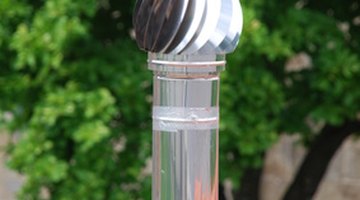How to Check Plumbing Vents
The purpose of plumbing vents is not only to release sewer gases, but to allow air into the waste lines. When water rushes though a drain pipe, it creates a strong vacuum behind it. Without venting, this vacuum will suck air through P-traps connected to the drain line, and may even suck the water out of them.

Things You Will Need
- Ladder
- Garden hose
- Plumbing snake
- In-line vent
- Hacksaw
- ABS glue
You'll know this is happening when you hear gurgling sounds from adjacent drains when you release water into one that isn't vented. The gurgling is caused by the movement of the water in the traps as air rushes by.
-
Use a ladder to climb onto the roof or up the side of the house. Inspect the openings of the vents. Unlike gas vents, which are made of galvanized metal, plumbing vents are made from 2-inch plastic pipe. They usually extend through the roof above the bathroom. It is common for the openings to become obstructed by leaves, sticks or even dead birds. Clear away any obstructions you find.
-
Spray a jet of water down from a garden hose into the openings of vents you suspect are clogged to clear obstructions. If there are leaves or dirt collecting in elbows in the vent line, the water will move them along into the drain. Have someone listen for the sound of water spraying in the wall while you do this. If you hear suspicious sounds, or smell sewer gases, uncover the wall to inspect the vent line. It may be disconnected or broken.
-
Use a plumbing snake to loosen obstructions if the water backs up to the vent opening. Insert the end of the snake into the hole and unwind it, pushing it in until it encounters an obstacle. Turn the handle of the snake to work it through the obstacle. Periodically reel the snake back out of the vent to remove debris that may have collected on the end.
-
Install an in-line vent in any drain you suspect may be insufficiently vented. It is a plastic fitting that you can install like a coupling. Cut through the drain line with a hacksaw between the P-trap and the wall and glue the vent into the line with the vent cap facing up.
Tip
You can prevent debris from obstructing plumbing vents by fitting caps onto the openings.
Warning
An in-line vent is an emergency fix only. It is not code-compliant and should not be used in place of vent lines in new construction.
If you leave venting problems uncorrected, you may end up with dry P-traps, which will allow sewer gases into your house.
References
Tips
- You can prevent debris from obstructing plumbing vents by fitting caps onto the openings.
Warnings
- An in-line vent is an emergency fix only. It is not code-compliant and should not be used in place of vent lines in new construction.
- If you leave venting problems uncorrected, you may end up with dry P-traps, which will allow sewer gases into your house.
Writer Bio
Chris Deziel has a bachelor's degree in physics and a master's degree in humanities. Besides having an abiding interest in popular science, Deziel has been active in the building and home design trades since 1975. As a landscape builder, he helped establish two gardening companies.
Photo Credits
- chimney image by Gonçalo Carreira from Fotolia.com
- chimney image by Gonçalo Carreira from Fotolia.com
More Articles


